Last month we talked about liner protrusion, and how to set it. But, when discussing the basics of engine rebuilding, we should have started at the real beginning – the crankshaft and engine block. These two engine components are the foundation of all engines, and it’s critical that the work be performed by a reputable shop, with qualified employees, and great equipment. The machine shop we utilize was started in 1962, and the founder is now 78 years old – and he still goes to work every day. His two sons handle the day-to-day operations of the business, these days.
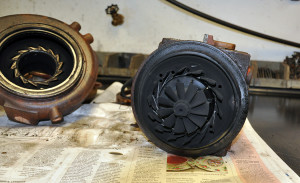 When rebuilding an engine, the first step is to hot-tank the crank and the engine block – this removes all the dirt and paint so the parts can be magnafluxed and makes visible any cracks. If the parts are crack-free, the engine block then has the line bore, where the crankshaft rides on the main bearings, checked for straightness. If it’s not perfectly straight, the line bore is honed until it is. Next, the block is checked for the distance from the center of the crankshaft bore to the top of the deck surface (this lets the machinist know if there is enough cast iron remaining on the block to be resurfaced and if the number one cylinder is the same height as number six). If the height of the front and rear cylinders is off, the block is then squared by resurfacing. The next process is cutting the upper counter bores, so the liner protrusion is correct.
When rebuilding an engine, the first step is to hot-tank the crank and the engine block – this removes all the dirt and paint so the parts can be magnafluxed and makes visible any cracks. If the parts are crack-free, the engine block then has the line bore, where the crankshaft rides on the main bearings, checked for straightness. If it’s not perfectly straight, the line bore is honed until it is. Next, the block is checked for the distance from the center of the crankshaft bore to the top of the deck surface (this lets the machinist know if there is enough cast iron remaining on the block to be resurfaced and if the number one cylinder is the same height as number six). If the height of the front and rear cylinders is off, the block is then squared by resurfacing. The next process is cutting the upper counter bores, so the liner protrusion is correct.
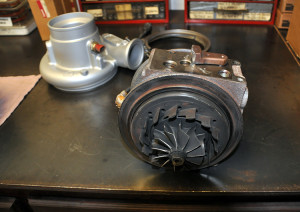 The crankshaft is now spun in a set of V-blocks with a dial indicator on the number four main bearing journal to see how many thousandths the crank is out of round. We have seen crankshafts as many as .028 out of round, and to have long engine bearing life, the crankshaft must be straight. A huge hook is mounted to a hydraulic ram that pulls the crank until it’s straight. After the line bore and/or crankshaft journal has been machined until they are perfectly straight and the crankshaft is straight, once you install the crank in the engine block, you should be able to spin it with one hand. Keep in mind that the average 12-liter to 16-liter crank weighs about 400 pounds, so to be able to spin that mass with one hand is remarkable. If you can’t spin it, either the line bore or the crankshaft is not perfectly straight. This is the foundation of building a solid engine – such as our Signature Engine at Pittsburgh Power.
The crankshaft is now spun in a set of V-blocks with a dial indicator on the number four main bearing journal to see how many thousandths the crank is out of round. We have seen crankshafts as many as .028 out of round, and to have long engine bearing life, the crankshaft must be straight. A huge hook is mounted to a hydraulic ram that pulls the crank until it’s straight. After the line bore and/or crankshaft journal has been machined until they are perfectly straight and the crankshaft is straight, once you install the crank in the engine block, you should be able to spin it with one hand. Keep in mind that the average 12-liter to 16-liter crank weighs about 400 pounds, so to be able to spin that mass with one hand is remarkable. If you can’t spin it, either the line bore or the crankshaft is not perfectly straight. This is the foundation of building a solid engine – such as our Signature Engine at Pittsburgh Power.
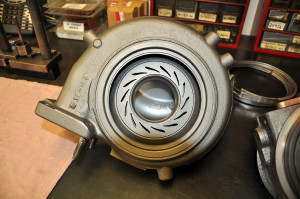 All diesel engines now, equipped with EGR, have variable geometry turbochargers. They are great turbochargers in design, but their failure rate is high because of the amount of soot in the environment they are forced to work in, and they are very expense to replace. The variable geometry vanes eventually accumulate the soot from the burned diesel fuel and the soot in the EGR gases. Once the soot accumulates on the vanes and the actuator can no longer move, the ECM will put the engine into a de-rate mode (or even a limp-home mode). The repair for this problem, up until now, was to replace the turbo, at a price of $2,100 to $3,500 plus labor, which makes for an expensive breakdown.
All diesel engines now, equipped with EGR, have variable geometry turbochargers. They are great turbochargers in design, but their failure rate is high because of the amount of soot in the environment they are forced to work in, and they are very expense to replace. The variable geometry vanes eventually accumulate the soot from the burned diesel fuel and the soot in the EGR gases. Once the soot accumulates on the vanes and the actuator can no longer move, the ECM will put the engine into a de-rate mode (or even a limp-home mode). The repair for this problem, up until now, was to replace the turbo, at a price of $2,100 to $3,500 plus labor, which makes for an expensive breakdown.
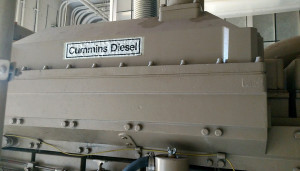 We have been rebuilding turbochargers at our shop for the past 40 years, so over the past couple of years, we have taken several of the variable geometry turbos apart to see just why they quit working. Usually, the compressor wheel, turbine wheel and shaft are still free and spinning in the exhaust flow and the bearings are still in good shape, however, most of the failures are from the variable geometry fins getting locked-up with soot or the actuator that moves the fins has failed. If you are somewhat mechanically-inclined, you can remove the turbocharger from the engine, remove the clamp that holds the turbine housing (exhaust housing) to the bearing housing, and clean the soot from the fins. I was recently able to talk an owner operator through this process on the telephone, and he also replaced the actuator on the turbocharger, as well, saving himself several thousands of dollars. I think what I’m going to do is start having a class on this subject and teach the owner operators that are in our driver’s lounge how to do this cleaning themselves.
We have been rebuilding turbochargers at our shop for the past 40 years, so over the past couple of years, we have taken several of the variable geometry turbos apart to see just why they quit working. Usually, the compressor wheel, turbine wheel and shaft are still free and spinning in the exhaust flow and the bearings are still in good shape, however, most of the failures are from the variable geometry fins getting locked-up with soot or the actuator that moves the fins has failed. If you are somewhat mechanically-inclined, you can remove the turbocharger from the engine, remove the clamp that holds the turbine housing (exhaust housing) to the bearing housing, and clean the soot from the fins. I was recently able to talk an owner operator through this process on the telephone, and he also replaced the actuator on the turbocharger, as well, saving himself several thousands of dollars. I think what I’m going to do is start having a class on this subject and teach the owner operators that are in our driver’s lounge how to do this cleaning themselves.
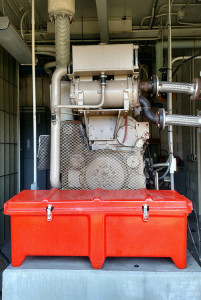 Every now and then a great deal comes along, and this one is almost too good to be true. If I didn’t know the person in charge of this piece of equipment and saw the pictures, I would not have believed it myself. For any of our owner operators that live on the islands such as Puerto Rico, the US and British Virgin Islands, Hawaii, or even small towns that need back-up electricity, here is a deal for you. It’s a KTA Cummins (19-liter) 1,150 cubic-inch, 560 horsepower, GS456KVA generator that only has 380 total hours of running time on it. This engine was started every Monday and ran for 15 minutes, and all of the maintenance was performed by a Cummins distributor.
Every now and then a great deal comes along, and this one is almost too good to be true. If I didn’t know the person in charge of this piece of equipment and saw the pictures, I would not have believed it myself. For any of our owner operators that live on the islands such as Puerto Rico, the US and British Virgin Islands, Hawaii, or even small towns that need back-up electricity, here is a deal for you. It’s a KTA Cummins (19-liter) 1,150 cubic-inch, 560 horsepower, GS456KVA generator that only has 380 total hours of running time on it. This engine was started every Monday and ran for 15 minutes, and all of the maintenance was performed by a Cummins distributor.
This is truly a turn-key generator that comes with Cummins touch pad controls, a Cutler-Hammer 800-amp main disconnect, an automatic transfer switch, updated controls with automatic start, and a double-wall, late model, 250-gallon fuel tank. This 19-liter KTA Cummins engine can be converted to run in a truck, and easily puts out 800 to 950 horsepower. Being this generator is in like-new condition, I thought someone just might want to keep it in its current configuration. To purchase this generator new today would cost about $155,000, however, I did mention this deal was too good to be true, right? The price for all the above-mentioned equipment is $42,000. This is NOT a home power plant – this is to power-up a small town or a manufacturing facility.
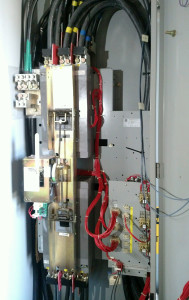 Another great item we currently have for sale is a C-15 single turbo Caterpillar engine with only 500,000 miles since its last rebuild. This engine just came out of the truck (the owner operator has moved to the south and is pulling light loads, so he installed a DD4 Detroit in his Pete 379 to try to obtain better fuel mileage). I have worked with he and his father for the past 40 years, and I did see and hear this engine run just last week. If you’re in need of a good used engine that doesn’t burn oil and runs great, this could be your engine! For more details, visit us online at www.pittsburghpower.com or call (724) 360-4080 today.
Another great item we currently have for sale is a C-15 single turbo Caterpillar engine with only 500,000 miles since its last rebuild. This engine just came out of the truck (the owner operator has moved to the south and is pulling light loads, so he installed a DD4 Detroit in his Pete 379 to try to obtain better fuel mileage). I have worked with he and his father for the past 40 years, and I did see and hear this engine run just last week. If you’re in need of a good used engine that doesn’t burn oil and runs great, this could be your engine! For more details, visit us online at www.pittsburghpower.com or call (724) 360-4080 today.

1 Comment
I really enjoy reading your tech articles. Thanks for all the great information. I do have a question. In several of the articles when talking about tuning and performance parts installed you talk about horsepower gains. But what about torque gains? Just curious because greater torque numbers help with fuel mileage. I’ve heard it said torque is what gets you there and your horsepower is how fast you get there.
Thanks again I would love to hear your thoughts.
Jarred Herman,